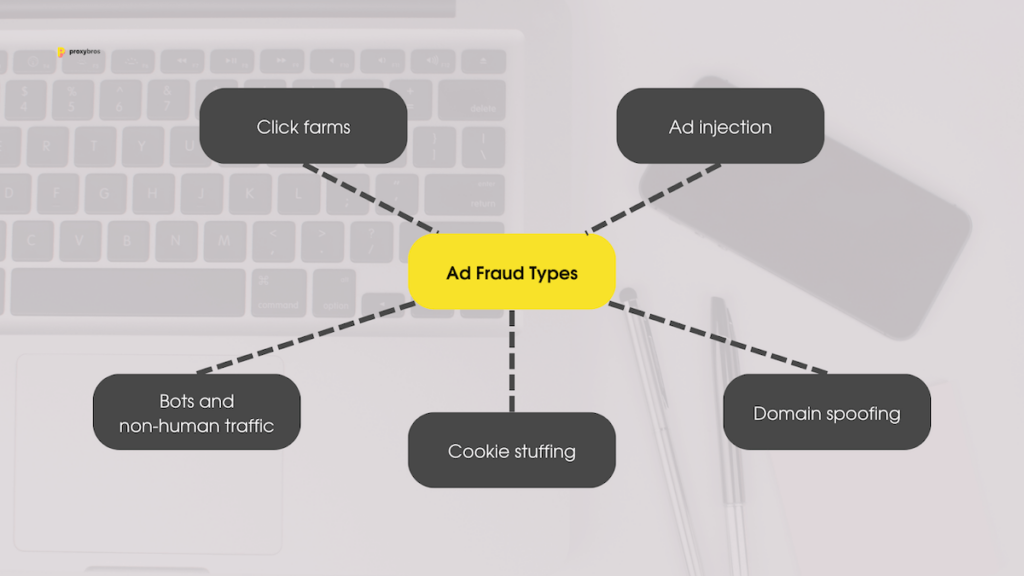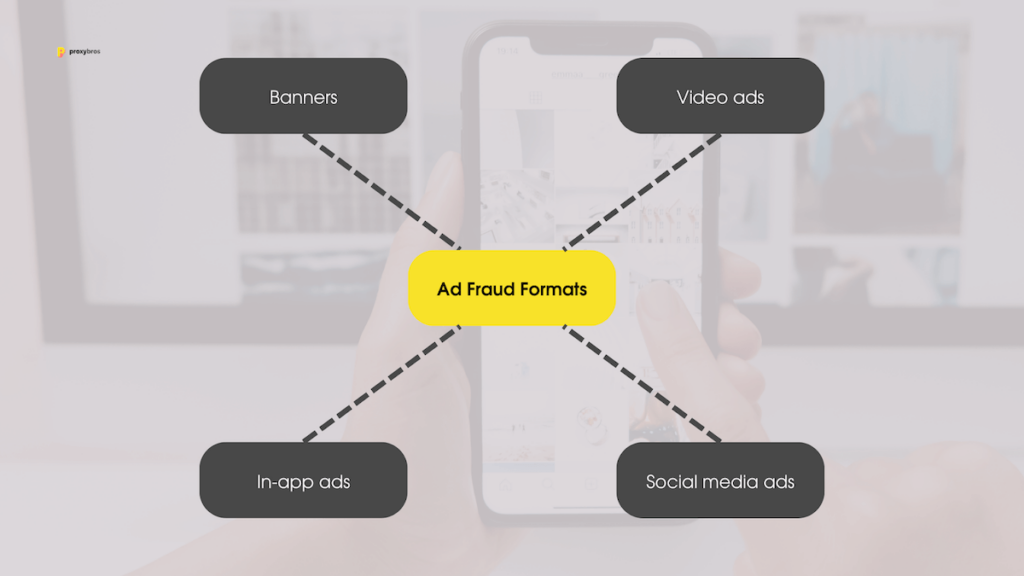Securing Digital Ad Ecosystems: Proxies as Shields Against Fraud and Bots

The need for robust security measures has never been more pronounced in the dynamic digital advertising landscape, where the intersection of technology and commerce fuels an ever-evolving marketplace.
As the digital ad ecosystem continues to expand, so too do the threats it faces, with fraud and bots posing significant challenges to the integrity and effectiveness of online advertising campaigns. In this era of data-driven marketing, where every click and impression holds immense value, safeguarding the authenticity and reliability of ad interactions has become paramount.
We delve into the pivotal role of proxies in fortifying digital ad ecosystems against the pernicious threats of fraud and bots!
Ad Fraud: The Threat Over Us All
A complex and rapidly evolving phenomenon, ad fraud threatens the very foundations of the digital ad ecosystem, undermining trust, eroding budgets, and tarnishing the integrity of online campaigns. As technology advances, so do the unlawful tactics employed by fraudsters, making it imperative for advertisers to comprehend the multifaceted nature of ad fraud and arm themselves with the necessary defenses.
⚔️ Unmasking the culprits: Types of ad fraud

This threat manifests in many forms, exploiting vulnerabilities within the digital advertising ecosystem. Among the most common types are:
- Bots/non-human traffic: Automated bots mimic human engagement, artificially inflating impressions and interactions to deceive advertisers into believing they are reaching a larger audience than reality.
- Click farms: Click farms employ low-wage workers or automated scripts to generate fake clicks and engagement, artificially inflating ad performance metrics.
- Ad injection fraud: Malicious software injected into users’ browsers displays unauthorized ads on legitimate websites, generating revenue for fraudsters.
- Domain spoofing: Fraudsters impersonate legitimate domains to sell ad inventory, leading advertisers to believe their ads are displayed on reputable websites.
- Cookie stuffing: Fraudsters stuff a user’s browser with cookies without their consent, enabling them to claim credit for ad interactions they did not generate.
⚔️ Navigating the battlefield: Ad fraud formats

Ad fraud is an omnipresent threat across various ad formats, exploiting vulnerabilities unique to each:
- Banner ads: Fraudsters can manipulate banner ad placements, artificially boosting impressions or interactions through automated scripts.
- Video ads: Ad fraud in video advertising involves fake views, plays, and interactions, misleading advertisers about the actual impact of their video campaigns.
- In-app advertising: Apps can be compromised by ad fraud, leading to fake installs, interactions, and in-app engagements, distorting advertisers’ perception of user engagement.
- Social media ads: Social platforms are not immune to such fraud, with fake likes, shares, and comments skewing the perception of ad performance.
⚔️ Magnitude and comparison: Ad fraud in the cybercrime landscape
The sheer magnitude of ad fraud’s impact is staggering. In a 2017 report by Juniper Research, advert fraud was estimated to be worth a staggering $19 billion, equivalent to $51 million per day. Ad fraud claims the ignominious title of the #1 cybercrime in revenue, surpassing tax-refund fraud.
HP Enterprise’s “Business of Hacking” report highlights advert fraud’s distinction as the easiest and most lucrative form of cybercrime. Its low entry barriers and potentially enormous profits make it attractive for malicious actors seeking quick financial gains.
Proxies, the Best Solution for Digital Security and Safety
So, maintaining a secure and safe environment has become a paramount concern for advertisers and businesses in the ever-evolving world of digital advertising, where the stakes are high and the competition is fierce.
As the ad ecosystem expands, so do the risks associated with online interactions, ranging from data breaches to identity theft and brand erosion. Amidst this backdrop, proxy servers have emerged as a steadfast and versatile solution, offering various benefits that address the multifaceted challenges of data safety, brand protection, and identity security.
🛡️ Guardians of data privacy
At the core of the digital realm lies an intricate web of data flows, where every click, view, and engagement generates a stream of valuable information. However, this treasure trove of data is not immune to prying eyes and malicious actors.
Proxy servers are the first defense against potential data breaches by masking users’ IP addresses and routing traffic through an intermediary server. This process, known as IP masking, ensures that sensitive user information remains hidden from unauthorized entities.
📖💡 Learn more! Datacenter VS Residential Proxies — Key Features, Principle of Work, Differences.
By adopting proxies, advertisers can rest assured that their customers’ data is safeguarded, enhancing user trust and fostering a sense of security in an increasingly data-driven environment.
🛡️ Preserving brand integrity
In the digital landscape, a brand’s reputation is a delicate construct built through years of meticulous effort and investment. Yet, this reputation can be easily tarnished by fraudulent activities, such as ad impersonation, click fraud, and brand counterfeiting.
Proxies offer a robust shield against these threats, enabling advertisers to monitor and control traffic sources accessing their ads. By analyzing incoming traffic patterns and identifying anomalies, proxies help detect and mitigate fraudulent activities, preserving brand integrity and ensuring that legitimate engagement remains at the forefront.
🛡️ Fortifying identity protection
As online interactions become more ingrained in our daily lives, the risks associated with identity theft and cybercrime have risen substantially. Proxy servers safeguard user identities by obfuscating their original IP addresses and shielding personal information from potential threats.
This layer of anonymity not only safeguards users’ privacy but also thwarts attempts at unauthorized access to sensitive data. Advertisers can leverage proxy technology to enhance their customers’ online experience, ensuring their identities are shielded from prying eyes.
🛡️ Enhancing global accessibility
The digital ad landscape knows no geographical boundaries, with campaigns reaching global audiences. However, varying regional regulations and access restrictions can pose challenges.
Proxies enable advertisers to navigate these hurdles by rerouting traffic through servers in different regions, allowing them to tailor content and campaigns according to local preferences and regulatory requirements. That ensures compliance and enhances user experiences by delivering relevant content to diverse audiences.
How Does a Proxy Server Work to Protect You from Fraud?
At its core, a proxy server is an intermediary between a user’s device and the internet. When an Internet wanderer sends a request to access a site or online resource, the request is routed through the proxy server before getting to its intended destination. This intermediary step forms the basis of the proxy’s protective capabilities, enabling it to exert control over the flow of data and interactions.
🌐 IP address masking
One of a proxy server’s primary and most significant functions is to mask the user’s original IP address. Every device, stationary or mobile, connected to the world web has a unique IP address, which can reveal valuable information about the user’s location and identity. By funneling requests through a proxy server, the user’s true IP address is concealed, making it challenging for fraudsters to pinpoint the traffic source. This obfuscation is a formidable deterrent against various types of advert fraud, particularly those that rely on identifying and exploiting vulnerable IP addresses.
🌐 Traffic routing and filtering
Proxy servers can be configured to route traffic through different geographic locations. This feature is invaluable for advertisers seeking to reach diverse audiences while also helping combat advert fraud. By rerouting traffic through specific regions, proxy servers enable advertisers to identify irregular patterns or sudden surges in engagement, a common hallmark of fraudulent activities.
Additionally, proxy servers can be equipped with filtering mechanisms that detect and block suspicious or malicious traffic, further fortifying the ad ecosystem against fraudulent behavior.
🌐 Session persistence and management
Proxy servers can facilitate session persistence, allowing users to maintain their connection to a website or online service even when they change IP addresses or network connections. This continuity enhances user experiences while thwarting fraudsters attempting to manipulate user engagement metrics by rapidly cycling through IP addresses.
By maintaining stable sessions, proxy servers bolster the accuracy of engagement data and provide a more transparent view of genuine user interactions.
Guide to Finding the Best Proxy Provider for Ad Fraud Protection
As the first line of defense against the pernicious threats of fraudulent activities, a reputable proxy provider can empower you with the tools and expertise necessary to navigate the complex realm of digital advertising securely.
📖💡 Learn more! What are Proxy Services? Explained.
So, this bonus guide will explore key considerations and actionable steps to help you find the best proxy provider to ensure your data is safe from advert fraud.
1️⃣ Understanding your needs and goals
Before embarking on the journey to select a proxy provider, it’s crucial to understand your specific needs and objectives clearly. Consider the following questions:
- What is your primary concern? Are you primarily concerned about IP masking, traffic routing, data privacy, or a combination of these factors? Identifying your main priorities will guide your search.
- What scale of protection do you require? Are you an individual advertiser, a small business, or a large enterprise? Your scale of operations will influence the level of protection you need and the resources you can allocate.
- What ad formats and platforms do you utilize? Different proxy providers may specialize in specific ad formats or platforms. Ensure your chosen provider can handle the formats and platforms you use.
2️⃣ Evaluating provider reputation and reliability
- Look for proxy providers with a strong reputation in the industry. Research reviews, testimonials, and case studies to gauge their track record in delivering effective advert fraud protection.
- Consider providers with a proven history of working with advertisers, agencies, and businesses in your niche. Their experience can provide insights into their understanding of your specific challenges.
- Transparency is key. Seek providers that are open about their methods, technology, and data handling practices. An accountable provider should be willing to address your questions and concerns.
3️⃣ Technology and capabilities
- IP diversity and geolocation: A robust proxy provider should offer various IP addresses from diverse locations. This feature enables you to emulate genuine user interactions and target specific geographic audiences effectively.
- Traffic filtering and anomaly detection: Look for providers that offer advanced traffic filtering mechanisms and anomaly detection. These tools can identify and block suspicious activity, safeguarding your campaigns from fraudulent engagement.
- Session persistence: Session persistence ensures a seamless user experience by maintaining connections even when IP addresses change. This feature is crucial for accurate data collection and analysis.
4️⃣ Customization and flexibility
- Tailored solutions: Your proxy provider should be willing to tailor their solutions to your specific needs. A one-size-fits-all approach may need to be revised to address your unique challenges.
- Scalability: As your needs evolve, your proxy provider should be capable of scaling their services to accommodate increased demand and expanding campaigns.
5️⃣ Cost and value
- Pricing models: Proxy providers may offer various pricing models, such as pay-as-you-go, subscription-based, or custom packages. Evaluate the pricing structure and ensure it aligns with your budget and usage.
- Cost-effectiveness VS quality: While cost is a consideration, prioritize quality and effectiveness over the lowest price. Investing in a reputable provider can yield higher returns by preventing advert fraud and enhancing campaign performance.
6️⃣ Customer support and collaboration
- Responsive support: Choose a reputable, reliable, and popular provider that offers responsive customer support. Timely assistance is essential for addressing any issues or concerns during ad campaigns.
- Collaboration and training: Look for providers that offer training resources, best practices, and educational materials. A provider willing to collaborate and share insights demonstrates their commitment to your success.
7️⃣ Trial period and onboarding
- Trial offer: Opt for providers that offer a trial period or demo. That allows you to assess the provider’s technology, features, and compatibility with your needs before committing.
- Onboarding process: A smooth onboarding process can significantly impact your experience with a proxy provider. Choose a provider with clear onboarding steps and guidance.
Staying Ahead in this Fight
In the intricate dance between innovation and security within the digital ad ecosystem, the role of proxies as vigilant shields against ad fraud and malicious bots shine ever brighter. As the digital landscape evolves and expands, so too do the challenges that threaten the authenticity and effectiveness of online advertising. Proxies emerge as indispensable allies, offering a multifaceted defense beyond conventional measures. By concealing IP addresses, intelligently routing traffic, and filtering out nefarious activity, proxies bolster data safety, brand protection, and identity security.
In this era of data-driven marketing, where trust and transparency are paramount, proxies stand as sentinels of integrity, ensuring that every click, impression, and engagement holds value. They empower advertisers and businesses to navigate the digital terrain with confidence and redefine the boundaries of what is achievable in a secure and equitable ad ecosystem. As we move forward, armed with the knowledge and insights into the pivotal role of proxies, the path ahead becomes clearer – one where genuine interactions triumph over manipulation and where the digital ad landscape flourishes under the watchful guardianship of these steadfast shields. In harnessing the power of proxies, we chart a course toward a future where authenticity reigns supreme, and the promise of digital advertising is realized to its fullest potential.
